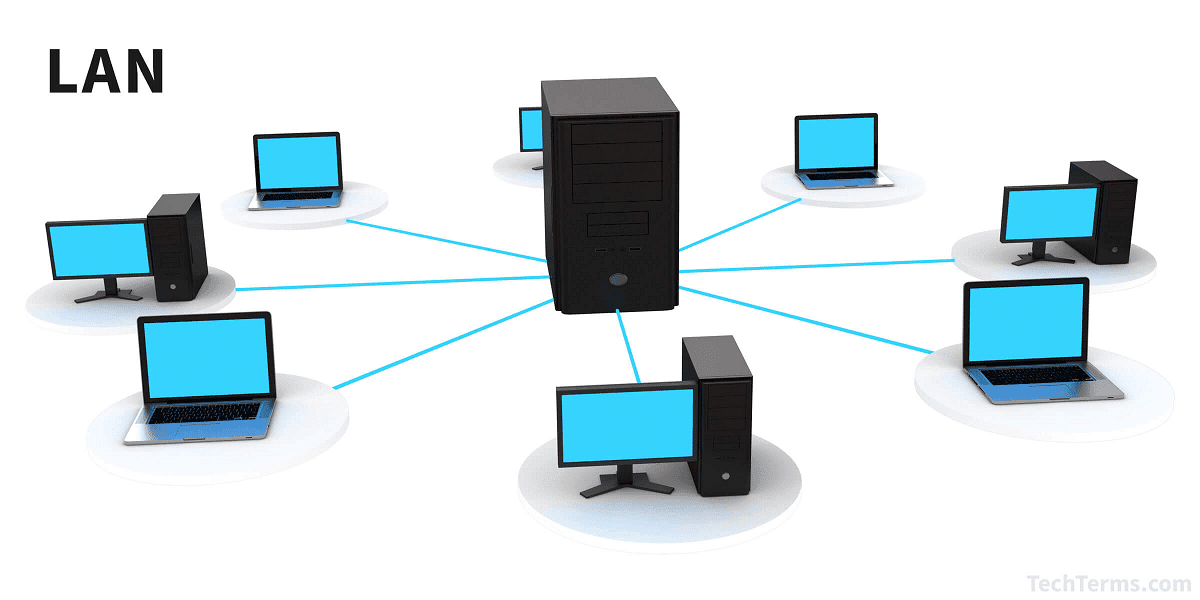A Local Area Network (LAN) is an assortment of devices and gadgets associated together in one physical area, for example, an office, or home. A Local Area Network can be little or huge, going from a home organization with one client to an undertaking network with a large number of clients and gadgets in an office or school.
Notwithstanding size, a LAN’s single characterizing trademark is that it connects the devices and gadgets that are in a solitary, restricted zone. Interestingly, a wide area network (WAN) or metropolitan region organization (MAN) covers bigger geographic zones. A few WANs and MANs interface numerous LANs together.
What’s in a LAN?
A LAN includes links, passages, switches, switches, and different segments that empower gadgets to associate with inside workers, web workers, and different LANs by means of wide zone organizations.
The ascent of virtualization has likewise filled the improvement of virtual LANs, which empower network overseers to sensibly aggregate organization hubs and parcel their organizations without a requirement for significant foundation changes.
For instance, in an office with numerous divisions, for example, bookkeeping, IT backing, and organization, every office’s PCs could be intelligently associated with a similar switch however divided to carry on as though they are isolated.
History of LAN
LAN started in the ether. Not the nineteenth-century idea of a puzzling, undetectable medium between the sun and the Earth that behaviors light — that is Aether; notwithstanding, it’s not far-removed to consider LAN and Aether in a similar setting.
Here’s a course of events that will reveal to you why:
1973: Birth of the Ethernet
Dr. Robert M. Metcalfe imagined the Ethernet in 1973. His activity was to organize all the PCs in a structure to one another and to the world’s first Xerox laser printer. In a reminder, he named the systems administration technique “Ethernet” on the grounds that the gigantic coaxial link that would interface the PCs to one another helped him to remember the Aether idea.
Metcalfe’s thought was educated by ARPANET — the first web created by the U.S. Branch of Defense—and the ALOHAnet, which was a parcel exchanging remote radio organization for PCs created by the University of Hawaii.
The Ethernet permitted PCs to send parcels of information through a coaxial link to speak with one another and the printer. It utilized an impact identification plot. In the event that hubs in the organization terminated simultaneously, causing an impact, the centralized server wouldn’t react and the hubs would then hold up an irregular number of milliseconds to fire once more.
1977: First business LAN
After four years, Datapoint Corp. introduced the main business LAN at Chase Manhattan Bank in New York. In contrast to Metcalfe’s Ethernet, Datapoint’s LAN utilized the Attached Resource Computer (ARC) organization. While Ethernet utilized crash identification, ARC utilized a token-passing plan to maintain a strategic distance from synchronous transmissions by hubs. At the end of the day, the hubs alternated sending signals as opposed to depending on arbitrary retransmission. Different organizations, for example, IBM, embraced the token-passing plan to fight Ethernet for LAN incomparability all through the ’80s.
1979: Ethernet accessible to people in general
Metcalfe began 3Com to create and sell Ethernet items.
1985: IEEE turns into the norm for LAN
Ethernet turned into the Institute of Electrical and Electronics Engineers’ (IEEE) standard for LAN.
1990: Ethernet prevails upon LAN
Ethernet had won the LAN fight, to a limited extent by changing to a curved pair link, which decreases crosstalk and electromagnetic acceptance. As it were, Ethernet was quicker.
1991: Work starts on remote LAN
The IEEE began dealing with remote LAN (WLAN), which depends on the ALOHAnet model.
1997: Wi-Fi is conceived
IEEE delivered the 802.11 (Wi-Fi) standard.
Rather than impact recognition, Wi-Fi utilizes a cautious transporter sense various access/crash shirking (CSMA/CA) plot. A Wi-Fi gadget tunes in to radio waves broadcast by the LAN for an irregular measure of time, and when the organization is inert, the gadget communicates a sign (outline). At the point when the beneficiary gets the casing flawless, it sends back an affirmation (ACK) to the sender. Remote LANs (WLANs) and LANs can get to the web or wide territory organizations (WANs) through a door
LAN and WAN | The difference
A wide zone organization (WAN) is a progression of LANs connected together to frame an organization in an all-encompassing region. WANs are regularly worked by media communications organizations or organizations that need an organization including numerous far off areas. The web itself is a WAN.
Fiber optic link is the favored transmission vehicle for WANs since fiber optic can send a lot of information at high speeds. Similar to the case with the web, a WAN can likewise incorporate metropolitan territory organizations (MANs).
LAN Server
A Local Area Network server, or document server, is a specific, rapid PC that houses the application projects and records for PCs on an organization. An organization chairman awards client admittance to applications and records on a LAN worker. LAN clients can download applications and records to get to them straightforwardly from the hard drive of their devices and gadget.
LAN versus Wi-Fi
Today, asking whether you should utilize a LAN Ethernet association or a Wi-Fi association resembles asking whether you need consistency or accommodation. Gigabit Ethernet is prepared to do reliably communicating information at velocities of 1000 Mbps and Fast Ethernet can deal with 100 Mbps. In an examination, the freshest Wi-Fi principles work as follows:
- 802.11ah: Operates on recurrence transfer speeds underneath 1GHz, which means it’s able to do longer separation transmission than different principles. The maximum velocity for 802.11ah is 347Mbps.
- 802.11ad: Operates on a transfer speed of 60GHz at speeds up to 6.7Gbps — quick, yet just works up to 11 feet from the entrance center point.
- 802.1ac (Wi-Fi 5): Operates on transmission capacity of 5 GHz or 2.4 GHz, contingent upon the switch, with speeds up to 3.46Gbps.
The last two principles are significantly quicker than Gigabit Ethernet, however, Lifewire’s Bradley Mitchell fights that these hypothetical Wi-Fi speeds don’t coordinate with the real speeds you’ll encounter. All things considered, Wireless Local Area Network permits you to move around advantageously with PCs and cell phones in the zone. You won’t experience the predictable speed of Ethernet, yet you will get genuinely high speeds and accommodation with the present innovation.



Simple Tips to Protect Your WiFi Network From Hackers
How Plugins Can Revolutionize Your App Development Experience